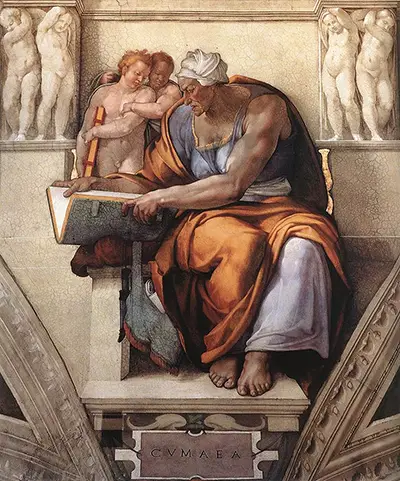A sibyl is essentially a female prophet and Michelangelo wanted to make his Sistine Chapel display as inclusive as possible. As such, he includes a good number of famous sibyls within his network of frescos and also made attempts to cover a variety of ages too. The Cumaean Sibyl was specifically a priestess who ruled over a Greek colony called Cumea which can be found relatively close to Naples in southern Italy. Michelangelo would have spent considerable time in selecting his prophets and sibyls from a long list who exist from ancient literature. He would then attempt to portray them in a manner which communicated something about their own lives within each artwork, normally through the use of symbolic objects which would each deliver a certain meaning for our benefit. In the example of this painting there is a large book which is being read by the main figure, and we can instantly identify this as a key symbolic addition that requires further investigation.
The Sibyl herself had a number of names, including Herophile of Pausanias and Lactantius. There was also Deiphobe, daughter of Glaucus, Amaltheia, Demophile and Taraxandra used in different contexts. Legend has it that she would live for a thousand years after being blessed by Apollo. Michelangelo himself would look far and wide for inspiration for his paintings, which ensures there is a good variety of content found across his extensive oeuvre. The life of Christ, naturally, dominates the most, but there are other elements such as this to be seen as well. Religion was a key part of society at this time and most of the wealthiest patrons were also connected to the Christian faith, making it inevitable that such themes would be prevalent within the careers of the old masters such as Michelangelo.
There is a huge cultural aspect to Renaissance art which you might not find in some of the more contemporary art that we enjoy today. Not only are we astounded by the technical qualities of artists such as Michelangelo, but we also become more aware of passages from Christian scripture as well as other classical literature. Poetry would also inspire some of the artist's work, before he later turned his hand to poetry himself. He would ultimately take on an almost endless series of challenges throughout his lifetime and a part of his genius-like reputation was in how many of these he could pull off at a high level. Today we celebrate his life just as much as any other artist from the centuries which followed on after the Italian Renaissance had come and gone.


